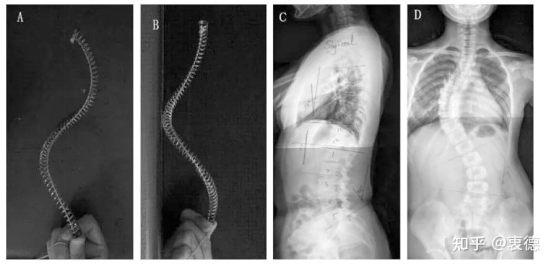








Spinal scoliosis is like a spring constrained by a rope, which causes rotational distortion in three-dimensional space. We refer to this theory as the spring three-dimensional spiral theory.
Cheng Y, Shi Y, Xu B, Yang Z. The uncoupled antagonist and posterior spinal ligament tension (UAPLT) - An improvement to three dimensional spring model of adult idiopathic syndrome (AIS) pathogenesis Med Hypotheses 2021 Jul; 152:110616. doi: 10.1016/j.mehy.2021.110616
According to this theory, it can basically explain the characteristics of all idiopathic scoliosis:
1. Right chest curvature and left waist curvature are more common: normal individuals have a certain degree of right chest curvature (less than 10 °) and rotation; The opposite is true for people with mirrored hearts, indicating that the direction of curvature of scoliosis may be related to the position of the heart. At the moment when the spring is about to deform, the tiny heart gravity may determine the direction of scoliosis.
2、Before puberty, everything is normal, and after puberty, it occurs: After puberty, humans secrete many hormones, the most representative of which is not only sex hormones, but also a hormone called relaxin3. RLN3 is an ancestral hormone that can cause extensive relaxation of ligaments, indirectly leading to tightening of the ligaments around the spine.

We found a significant increase in serum RLN3 levels in patients with scoliosis in 2022
3、More commonly seen in women, the female spine is like a more flexible spring, which is more prone to bending after being pulled. At the same time, estrogen enhances the secretion of RLN3 in the hypothalamus through the gonadotropin-releasing hormone axis.
4、Dance and rhythmic gymnastics athletes both artificially stretch the anterior ligaments of the spine, indirectly leading to a relatively stronger pulling effect of the ligaments around the spine, resulting in a much higher incidence of scoliosis.

5、Patients with scoliosis may experience sagittal plane flat back deformity: Scoliosis is the result of physiological curvature of the human spine rotating to other planes in the coronal plane (scoliosis), and sagittal plane may also appear (reduced thoracic kyphosis, flat back). Scoliosis is the result of physiological curvature of the human spine rotating to other planes in the coronal plane (scoliosis), and sagittal plane may also appear (reduced thoracic kyphosis, flat back).

6、In patients with scoliosis, the front of the vertebral body grows faster than the back: after being restrained by a rope, according to Hueter Volkmann's law, the bone grows slower under compressive stress, grows faster under tensile stress, and the front of the vertebral body begins to grow too quickly.
7、Only humans experience scoliosis: Spinal scoliosis is the cost of upright walking, and the most stable mechanical state of the upright spine is the three-dimensional spiral state. However, under normal circumstances, it is restricted by the muscles and ligaments on both sides and maintains physiological curvature in the sagittal plane. Once the ligament pulling effect is enhanced (rope pulling spring), the spine will return to its most stable state, which is the three-dimensional spiral state of the spring.
In summary, scoliosis is like a stretched spring, it is not caused by poor posture, asymmetrical muscles on both sides, or a single shoulder backpack. With the support of the three-dimensional spiral theory of scoliosis, it provides us with important indications for prevention and treatment: it is possible to correct some mild scoliosis through specific muscle training and ligament release



